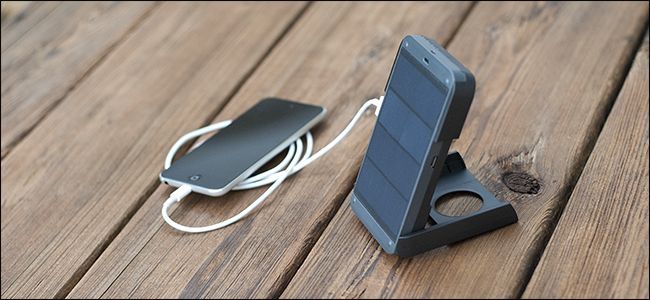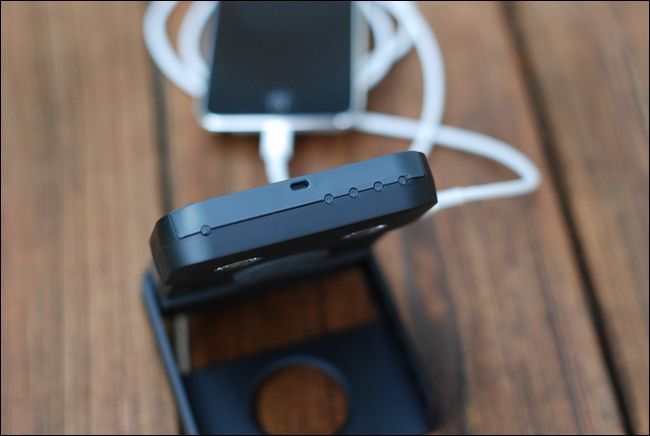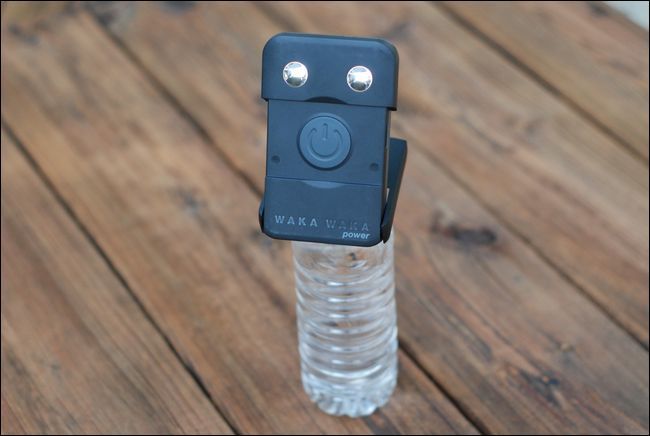Quick Links
Anyone with a power hungry gadget, let alone a bag bursting with them, can tell you how much energy it takes to keep a modern arsenal of gadgets up and running. Read on as we review the Waka Waka, a combination battery pack and solar charger that ensures you'll have ample and free power wherever you roam.
What Is The Waka Waka?
The Waka Waka is a combination battery pack, solar charger, and emergency/task light designed for use both in urban/suburban settings as well as off the grid to provide power solar power for small to mid-size devices as well as a portable source of light.
The device features two large LEDs, a large easy-to-access power button, a folding stand that can also be used to mount the device on water bottle (or similar container) or to hang the unit, and contains a 2200mAh battery (enough juice to fully charge an iPhone or ebook reader once, a smaller device like a camera or MP3 player a few times, or to partially charge a tablet). If the unit is used to power just the lights and not an attached device then a full charge can provide between 10 to 150 hours of light depending on the level of brightness (adjustable between 5 and 70 lumens). The LED light function even includes an SOS signal. The units come in black-on-black and yellow-on-black color schemes.
Although not a feature accessible to the consumer, the Waka Waka also comes with a pretty great additional purchase benefit. Every time someone purchases a Waka Waka, the company donates a Waka Waka to a disaster area or region in a developing nation; to date they've donated 81,000 units to help people in 25 countries including Haiti, the Philippines, and Syria. At first glance it might seem like a solar USB charger isn't exactly the kind of thing a refuge needs but increasingly people around the world rely on mobile phones and there is a constant struggle for safe sources of light. The Waka Waka offers free light to many people who have previously lit their homes with expensive, inefficient, and dangerous kerosene lamps.
How Do I Use It?
The Waka Waka functions like most battery packs with a few additional features built in. Before we look at those features, however, let's clear up a common misconception people have about the Waka Waka (and similar solar-driven power packs). The Waka Waka does not provide on-the-fly solar conversion to continuously power an attached device. You can't plug your iPhone into it, point it at the sun, and expect to maintain 100 percent battery life on your iPhone as long as the sun is shining.
To use the Waka Waka you need to first charge the device. You can do so the traditional way by tethering it to your computer or cellphone wall charger via micro USB cable. When charging traditionally the unit takes approximately six hours to completely charge. When charging via the solar panel the charging process takes approximately 10 hours.
Once charged, you simply plug in your device to the USB port located on the side of the device and press the large power button on the body of the Waka Waka. One tap on the button activates the LED indicators on the top of the unit and sends a signal to check if a device is attached.
The unit includes a fold-out stand that serves several functions. You can stand it up on a flat surface like an easel. You can use the hole in the stand to mount it on a water bottle. You can even hang it by attaching a string to the top of the unit and running it through the hole (so the light shines down).
To activate the light and cycle through the brightness levels simply press the power button again and tap it until you've achieved the desired brightness (or turned the device off). One clever trick we discovered while playing with the device is to attach it to a large water bottle or milk jug and flip the stand so that the light shines down into the container (instead of out away from the bottle-as-stand). This creates a large and diffuse source of light that isn't as intense as the headlight-like blast the powerful pair of LEDs puts out.
The Good, The Bad, and The Verdict
When you combine functions into a single device, there's always a risk of creating a device that fails to do any of the things it was designed to do well. How does that play out in the case of the Waka Waka? Let's break it down.
The Good
- One of the principal complaints we make about most battery packs is that they lack a good LED light; the Waka Waka offers serious illumination.
- Although we initially thought of the stand/water bottle hole concept was a bit gimmicky, we ended up rather impressed with how well it worked.
- The stand also serves as a cover for all the ports on the device, a clever way to protect things when the device isn't in use.
- You buy one, and they donate one to a person in need.
The Bad
- The internal battery pack is small. Yes, it makes for a very portable device that doesn't weigh three pounds, but it also means you won't be charging your iPad off the Waka Waka.
- Only one 1A port; lacks a second port or a fast-charge 2.1A port.
- Although the panel is efficient for its size, there are other small chargers on the market with with larger/more efficient charging panels.
- At $70 retail, if the Waka Waka doesn't fulfill a specific set of needs you have (e.g. solar power while off grid and a bright light) then you're overpaying for an underpowered battery pack.
The Verdict
If the farthest you ever get from a power outlet is a table in the middle of the room at your local Starbucks, the Waka Waka is probably not for you. If, however, you're looking for a device that allows you to charge your devices away from the grid when you need it and provides hours and hours of light via a very efficient LED setup, the Waka Waka is the niche charger you're looking for. It's well designed, it's lightweight, and not only do you end up with a handy solar light/phone charger for your next hike, but somebody somewhere in the world ends up with one too.



